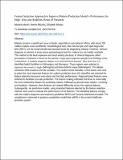Feature Selection Approach to Improve Malaria Prediction Model’s Performance for High- and Low-Endemic Areas of Tanzania

View/
Date
2024-06Author
Mariki, Martina
Mduma, Neema
Mkoba, Elizabeth
Metadata
Show full item recordAbstract
Malaria remains a significant cause of death, especially in sub-Saharan Africa, with about 228
million malaria cases worldwide. Parasitological tests, like microscopic and rapid diagnostic
tests (RDT), are the recommended and standard tools for diagnosing malaria. However, clinical
diagnosis is advised in areas where parasitological tests for malaria are not readily available.
This method is the least expensive and most widely practiced. A clinical diagnosis called
presumptive treatment is based on the patient’s signs and symptoms and physical findings at the
examination. A malaria diagnosis dataset was extracted from patients’ files from four (4)
identified health facilities in Kilimanjaro and Morogoro. These regions were selected to
represent the country’s high- (Morogoro) and low-endemic areas (Kilimanjaro). The dataset
contained 2556 instances and 36 variables. The random forest classifier, a tree-based, was used
to select the most important features for malaria prediction since this classifier was selected for
feature selection because it was robust and had high performance. Regional-based features were
obtained to facilitate accurate prediction. The feature ranking indicated that fever is universally
the most noteworthy feature for predicting malaria, followed by general body malaise, vomiting,
and headache. However, these features are ranked differently across the regional datasets.
Subsequently, six predictive models, using important features selected by the feature selection
method, were used to evaluate the performance of the features. The identified features comply
with the malaria diagnosis and treatment guidelines WHO and Tanzania Mainland provided. The
compliance is observed to produce a prediction model that will fit in the current healthcare
provision system.
URI
https://doi.org/10.1007/978-3-031-56576-2_6https://dspace.nm-aist.ac.tz/handle/20.500.12479/2790
